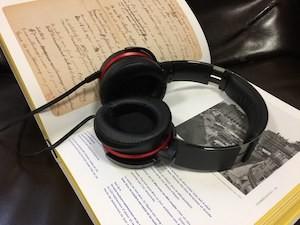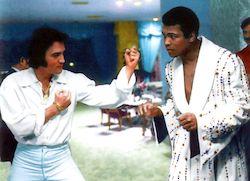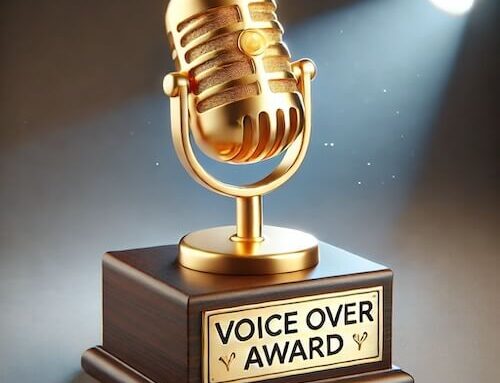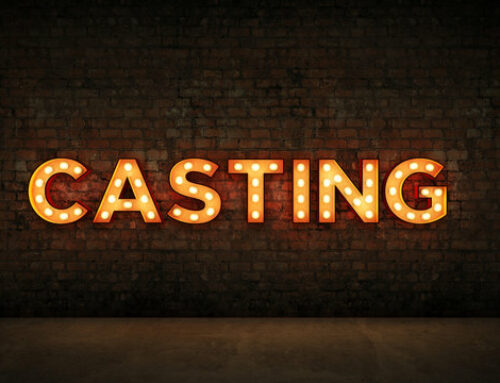Voice over, narration and audiobooks, let's talk about it
In this article
· Narration: a craft in its own right
· Storytelling: not reading aloud
· Imperfections and breaths: for a more human performance
· Workflow : the options
· Audiobooks: a labor of love
Audiobook narration is more than just a separate discipline within the voice over industry: it's a completely different beast.
Audio books: reading aloud?
 As a French voice actor (or any voice actor), we can be confident of being able to tackle audiobook narration without being prepared for it. After all, it's all about speaking into a microphone, isn't it? Of course, like being a voice actor is just about talking into a microphone. Yes, that's sarcasm.
As a French voice actor (or any voice actor), we can be confident of being able to tackle audiobook narration without being prepared for it. After all, it's all about speaking into a microphone, isn't it? Of course, like being a voice actor is just about talking into a microphone. Yes, that's sarcasm.
Narrator is a skill in its own right. It has nothing to do with voice overs, apart from the fact that for both, we use our vocal chords. It's a bit like a carpenter and a blacksmith: they both use their hands and tools that are sometimes a bit similar, but that's where the similarity ends.
Narrating requires a radically different approach to text: it means taking listeners into the world of the story being told, with a rhythm and melody that will make them want to project themselves into the story right to the end - and not everyone can do that. Some very good voice over talent are incapable of doing that, and some very good narrators are incapable of excelling as commercial or corporate voice overs.
Well, it's all about telling a story, isn't it?
The people I coach or who have done voice over training in individual coaching or in a workshop with me will tell me, "Wait a minute, Pierre, don't you say that everything is about telling a story, even if it's a 5-word TV ad signature? And I'll reply "Easy there, yes I'm saying that, but a 5-word story and a 150,000-word story are not the same thing".
Some people say that storytelling is 'reading aloud'. Semantics aside, and without wishing to engage in over-the-counter semiology or harm beetles, the choice of words is important. Narrating (or any work with a microphone, for that matter) has nothing to do with reading. You read with your eyes - you speak with your mouth. The difference between reading and speaking.
Reading is the process of decoding and recognising characters. Narrating is the process of telling a story, just as storytellers used to do in the old days around the fireplace, or still do in some countries in the village square. And unlike storytellers, with a written, imposed script. Alone, in front of a microphone, without an audience, in an acoustically treated booth whose sound is therefore not natural for an indoor space. But otherwise, it's no different.
What about breathing?
The breaths debate... Should they be removed? Should they be left in? So... when there's a soundtrack, with music, SFX, as with this Paris 2024 Olympic Games BBC launch promo for example, the sound engineers obviously remove the breaths. But when the end result is the voice and nothing but the voice?
As I said earlier, we're storytellers. We talk to people and tell them a story. Except that people can't see us, and we can't see them either. To overcome this handicap (even leaving aside Albert Mehrabian's rather simplistic 7-38-55 rule, more than 50% of communication is non-verbal in real life), the idea is to make our interpretation as human as possible.
And when humans speak, they sometimes search for words, sometimes they get carried away and sometimes they slow down. And it breathes, sometimes in the middle of a sentence, it doesn't respect punctuation because in oral transmission, punctuation doesn't exist, in short, it doesn't try to do what voices generated by artificial intelligence do very well. I discuss this in my article Voice Over And Artificial Intelligence.
It's our 'imperfections' that make us human, and I've developed this subject in a separate article, A Plea for Imperfection which I urge you to read. And the people who listen to the stories connect much better with humans than with robots.
That said, we generally deliver bad takes removed but not cleaned, and it's up to the client to decide what to do with the audio. But, as you will have realised, I would strongly recommend keeping what allows listeners to project themselves into the story by connecting with the storyteller.
What do we physically read?
You mean, what medium do we use to tell the story? I know I'm being heavy-handed here, but if it helps to get the message across, I won't hesitate to use hammertherapy. It's essential, vital, to understand the difference between reading and narrating.
Now that I've finished doing my bolosse (wesh wesh I'm talking the youngster in real bro), the answer: generally, we receive an electronic document that we display on the cabin monitor screen, or ipad, whatever. We can also do it the old-fashioned way, by printing the book. Yes, that's still done.
Why do I always ask for a document in editable format? Because I can change the font and the body of the text. A minor detail for some, but for me it means a lot, as I'm a miro. Some people are more comfortable with serifs, others with sans-serifs, in short, being able to edit the text is a must. I'm talking about the presentation of scripts in A Little Guide To The Dream Voice Over Session.
How do you tell the story?
We tell the story the way the customer wants us to tell it. Because we're service providers, serving customers - more on this in my article A Matter of Organs. If your client hasn't given you a brief, ask. If the answer doesn't seem precise enough, ask again until you are clear about what is expected of you.
The same goes for the interpretation of the characters: subtle, strong... Everyone has their own preferences, and it's not up to us to decide. Once again, we're not artists, we're service providers - never forget who signs the cheque. I develop this point in my article Artists Exit.
What about links? I'm repeating myself, but the text should guide you. A word of advice: once everything is clear, record for a few minutes and send to your client for approval. If he wants to adjust the tone, it's better to do it now than after delivery of the first 62-page chapter. Smells of experience, doesn't it?
On the technical side: rock'n'roll or punch'n'roll?
 I'm not talking about Elvis versus Ali (hilarious, isn't it?) but about the methods used to record audiobooks. There are two schools: punch'n'roll, and rock'n'roll. If you are unfamiliar with some of these terms, click on them for a definition in my Voice Over Dictionary.
I'm not talking about Elvis versus Ali (hilarious, isn't it?) but about the methods used to record audiobooks. There are two schools: punch'n'roll, and rock'n'roll. If you are unfamiliar with some of these terms, click on them for a definition in my Voice Over Dictionary.
Personally I rock'n'roll and pick up directly without stopping, I find that it helps to keep the flow, and the bad takes removal process is easy thanks to the clicks visible on the waveform, but to each his own. As the Brits say, the proof is in the pudding.
I'm talking about working in a private studio - in a commercial studio, all you have to do is narrate, and the sound engineer does the rest. Luxury, calm and pleasure!
And what about the money?
 But of course, yachts, helicopters, private jets, dream mansions... No, you can't get rich with audiobooks. You've got to love long-form narration (and have the skills), so it's not for everyone. On the other hand, getting to grips with narration is an excellent exercise for everyone: you learn to settle into the script, listen to the text and let it take you where it wants to go, and it's a fantastic workout for the vocal cords which, let's not forget because it doesn't hurt, are muscles.
But of course, yachts, helicopters, private jets, dream mansions... No, you can't get rich with audiobooks. You've got to love long-form narration (and have the skills), so it's not for everyone. On the other hand, getting to grips with narration is an excellent exercise for everyone: you learn to settle into the script, listen to the text and let it take you where it wants to go, and it's a fantastic workout for the vocal cords which, let's not forget because it doesn't hurt, are muscles.
Unlike other disciplines, audiobooks are paid by finished hour. Please note: the 'finished' in finished hour does not mean 'ready for distribution', but refers to the total listening time of the file. If your client pays you $300 per finished hour and the total listening time for the book is 12 hours, you will be paid $3,600 for the book.
Generally, prices include removal of bad takes but not the cleaning. If your client asks you to deliver cleaned up, add €100 per finished hour and subcontract, because if you don't, you'll quickly run out of hair from pulling it out. Sound engineering is a profession, and it's not ours.
Make sure you establish the conditions with your client BEFORE you start recording. In writing, because what you say goes, what you write stays. And do yourself a favour, don't undercharge - more on that in this article on voice over rates.
But otherwise it's a snap, isn't it?
No. Many a voice over talent has had a tough time of it. As I said earlier, it's a separate discipline that takes time to master in order to produce good work. With a lot of experience, you can produce a finished hour of footage in two hours in the studio, including diagonal pre-reading. But that's with lots and lots of experience.
A word of advice: if the book contains technical or foreign language terms that you don't master perfectly, ask your client for a pronunciation guide. You'll thank me later.
Tell your story well, and if this article has inspired you, perhaps it will inspire your colleagues too, so be generous with them and share it! I also invite you to share your experience here and leave your comments, suggestions or questions. I'll do my best to answer them!
PS: by subscribing to this voice over blog, you will have exclusive access to new articles before they are officially published. It's free so make the most of it, subscribe now !





Write a comment